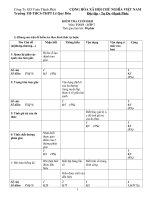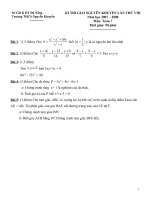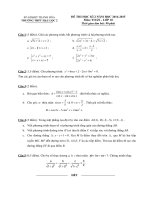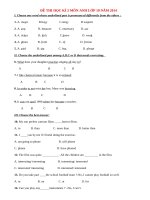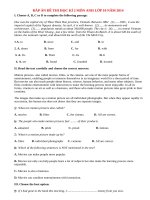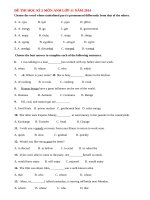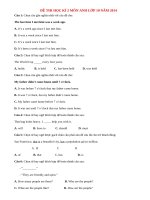Tải Đề thi học kì 2 lớp 7 môn Tiếng Anh có file nghe năm học 2018 - 2019 số 6 - Đề thi học kì 2 môn Tiếng Anh lớp 7 có đáp án
Bạn đang xem bản rút gọn của tài liệu. Xem và tải ngay bản đầy đủ của tài liệu tại đây (101.82 KB, 6 trang )
<span class='text_page_counter'>(1)</span><div class='page_container' data-page=1>
<b>ĐỀ THI CUỐI HỌC KÌ 2 LỚP 7 NĂM HỌC 2018 - 2019</b>
<b>MÔN TIẾNG ANH</b>
<b>I. LISTENING</b>
<b>1. Listen to Minh predicting the future. Decide if the statements are true (T) or false</b>
<b>(F). Circle T or F. You will listen TWICE.</b>
1. There will be flying cars and robots. T F
2. Everything will be green. T F
3. We will use more energy from the sun. T F
4. We will not like touch screen. T F
5. A serious sickness will be cured. T F
<b>2. Listen to the following interview with Lana Russel, a social worker in India. Fill </b>
<b>each of the gaps in the notes with NO MORE THAN THREE words and/or a </b>
<b>number. You will listen TWICE.</b>
<b>THE WORLD’S SLUMS</b>
- Slums = overcrowded sections of a city where people live in or near (1) _____________
- 2012: 33% of (2) _____________ live in slums
- Biggest slum in the world: Neza-Chalco-Itza in (3) _____________: 4 million people
- Biggest slum in Asia: Dharavi in India: (4) _____________ people
- A major cause of slums: (5) _____________ immigration.
<b>II. READING</b>
<b>1. Read the passage and answer the questions. Circle A, B, or C.</b>
How can we solve the problem of traffic congestions in big cities? Governments have
built highways, offered public transportation, etc. However, these traditional approaches
are becoming expensive. Many experts now see intelligent transportation systems (ITS)
as the solution. But how does ITS work?
</div>
<span class='text_page_counter'>(2)</span><div class='page_container' data-page=2>
etc.) receive ITS data, then use it to control the system by changing traffic signal timing,
broadcasting radio announcements, opening and closing roads and traffic lanes,
responding to accidents and the like. Computers, rather than humans, make most of the
decisions that control the system.
1. What does the passage mostly do?
A. suggest a solution to a problem
B. question a suggested solution
C. explain how a solution works
<b>2. What can the word “broadcast” be best replaced by?</b>
A. drive
B. send
C. direct
<b>3. What does the word “These” in paragraph 2 refer to?</b>
A. messages
B. devices
C. routes
4. According to the passage, what happens to the data collected by sensors, cameras,
satellites, etc.?
A. It is stored in computers for later use.
B. It is transmitted to drivers and traffic managers.
C. It is used by engineers to change the system.
5. Which of the following can be inferred from the passage?
A. ITS will offer a cheaper solution to solving traffic problems.
B. Machines will replace human beings in managing traffic system.
C. Governments will switch to ITS instead of using traditional measures.
<b>2. Read a passage about fossil fuels. Decide if the statements are true (T) or false (F).</b>
<b>Circle T or F.</b>
There are three major forms of fossil fuels: coal, oil and natural gas. All three were formed
many hundreds of millions of years ago before the time of the dinosaurs – therefore we call
them fossil fuels.
</div>
<span class='text_page_counter'>(3)</span><div class='page_container' data-page=3>
the fuels that were made more than 300 million years ago. They are not renewable like solar
power, wind power, hydro power or biomass. Once they are gone they are gone. So, it’s best
not to waste fossil fuels.
We can save fossil fuels by conserving energy. One simple way to do this is to turn off
appliances, TVs and radios that we are not using. We can also turn off lights when no one is
in the room. Another way is to go by bike or walk instead of driving cars or motorbikes.
1. Three major forms of fossil fuels are oil, coal and natural gas. T F
2. They were formed right after the time of dinosaurs. T F
3. Once fossil fuels are gone, they will come back later. T F
4. Hydro power and biomass are non-renewable sources. T F
5. Conserving energy is a good way to save fossil fuels. T F
<b>III. WRITING</b>
<b>1. For each question, complete the second sentence so that it means the same as the </b>
<b>first. Use the word in brackets. You may need to change the word.</b>
<b>Here is an example.</b>
0. The bookshop is opposite the library.
_________________________ a bookshop opposite the library. (THERE)
<i><b>Answer: 0. There is</b></i>
1. This is my car.
This car _________________________. (MINE)
2. My mom drives me to school every day.
I _________________________ car every day. (IN)
3. Tom always walks to school.
Tom _________________________. (FOOT)
4. How fast is that flying car?
What _________________________ flying car? (SPEED)
5. 200 people can go in that new train.
</div>
<span class='text_page_counter'>(4)</span><div class='page_container' data-page=4>
<b>2. There is a writing competition at your school about the way we will travel in the </b>
<b>future. Now write a paragraph (80-100 words) to send to this competition.</b>
You should use the following cues:
- What it is
- How it looks
- What it can do
- Why it will be used in the future
<b>ĐÁP ÁN</b>
<b>I. LISTENING</b>
<b>1. Listen to Minh predicting the future. Decide if the statements are true (T) or false</b>
<b>(F). Circle T or F. You will listen TWICE.</b>
1. F 2. T 3. T 4. F 5. T
<b>TASK 1. Listen to Minh predicting the future. Decide if the statements are true (T) </b>
<b>or false (F). Circle T or F. You will listen TWICE.</b>
<b>Now listen and circle T or F.</b>
I’m only 14, therefore if I'm lucky I'll have another 70 years ahead of me. I've been
thinking about the future. Personally, I don't think there will be flying cars and robots.
Everything will be very green. In fact, my city just started the green bin programme. I
think we'll increase our solar and wind energy. Cars will run off very little gas. And 80%
of appliances will be environmentally safe. Perhaps even farm skyscrapers in the middle
of cities.
I think almost everything will be touch screen. Microwaves, TV remotes, calendars,
laptops, cell phones, ovens, etc. It just seems that everything is turning touch screen! I
think there will be less religion, and more science. We'll be very interested in space. We
will have incredible inventions. Perhaps a cure for cancer?
(Dừng)
</div>
<span class='text_page_counter'>(5)</span><div class='page_container' data-page=5>
<b>2. Listen to the following interview with Lana Russel, a social worker in India. Fill </b>
<b>each of the gaps in the notes with NO MORE THAN THREE words and/or a </b>
<b>number. You will listen TWICE.</b>
(1) housing conditions
(2) the urban population
(3) Mexico City
(4) one/1 million
(5) rural-to-urban
<b> TASK 2. Listen to the following interview with Lana Russel, a social worker in </b>
<b>India. Fill each of the gaps in the notes with NO MORE THAN THREE words </b>
<b>and/or a number. You will listen TWICE.</b>
<b>Now listen and fill the gaps. </b>
<b>Interviewer: The first question for you, Lana: What are slums?</b>
<b>Lana: Broadly speaking, slums are overcrowded sections of a city or town in which most </b>
inhabitants are poor and live in terrible housing conditions. Sanitation is also bad in these places.
<b>Interviewer: Approximately how many people live in slums today?</b>
<b>Lana: In 2012, the UN estimates that 863 million people are living in slum conditions. That’s </b>
around 33% of the urban population.
<b>Interviewer: Where are the biggest slums?</b>
<b>Lana: The biggest one is Neza-Chalco-Itza in Mexico City with roughly 4 million people. The </b>
largest in Asia is Dharavi in India with about one million residents.
<b>Interviewer: Why do slums exist?</b>
<b>Lana: There are a number of factors but a major one is rural-to-urban migration. Poverty is another </b>
factor.
(Dừng)
Now listen again. (phát lại bài nghe)
(Dừng)
<b>II. READING</b>
</div>
<span class='text_page_counter'>(6)</span><div class='page_container' data-page=6>
1. C 2. B 3. A 4. B 5. A
<b>2. Read a passage about fossil fuels. Decide if the statements are true (T) or false (F).</b>
<b>Circle T or F.</b>
1. T 2. F 3. F 4. F 5. T
<b>III. WRITING</b>
<b>1. For each question, complete the second sentence so that it means the same as the </b>
<b>first. Use the word in brackets. You may need to change the word.</b>
1. This car is mine.
2. I go to school in my mum’s car every day.
3. Tom goes to school on foot.
4. What is the speed of that flying car?
5. That new train can carry 200 people.
<b>2. There is a writing competition at your school about the way we will travel in the </b>
<b>future. Now write a paragraph (80-100 words) to send to this competition.</b>
<i>My invention is a flying car. Since I saw Back to the Future, I have always wanted to </i>
own a flying car. Well, it looks just like a normal car with no wings. It can fly because it
has a special engine that runs by solar energy. It does not need a runway to take-off,
either. It can run on roads and of course it can fly on air, too. I will not have to worry
about traffic jams. That is why it will be popular to everyone.
Mời bạn đọc tham khảo thêm tài liệu Tiếng Anh lớp 7 tại đây:
Bài tập Tiếng Anh lớp 7 theo từng Unit:
Bài tập Tiếng Anh lớp 7 nâng cao:
</div>
<!--links-->
